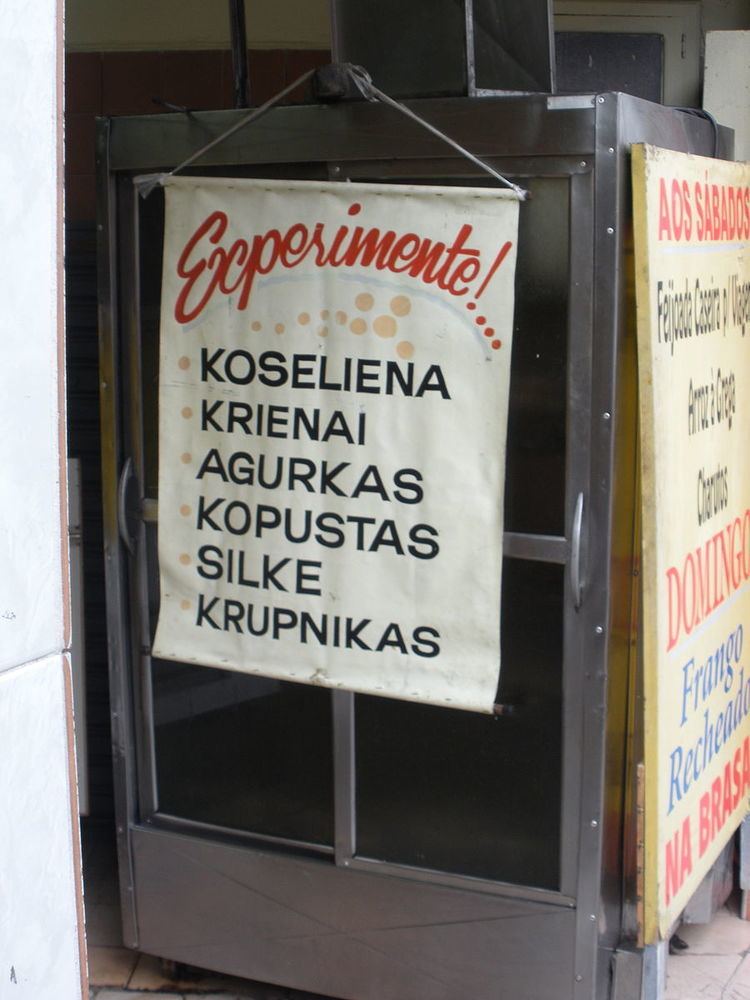 | ||
Lithuanian Brazilians (Portuguese: Lituano-brasileiros) are Brazilian citizens who are fully, partially, or predominantly of Lithuanian descent, or are Lithuanian-born people residing in Brazil.
The first Lithuanian to set foot on Brazilian soil, according to a record dated in 1866, was a certain colonel Andrius Višteliauskas. His mission was to aid the Brazilian armed forces in the Paraguayan War that was going on at that time. His experience in Brazil must have influenced people in his homeland, perhaps by his writings or perhaps after he traveled home. Therefore, a few years later a group of Lithuanian immigrants and their families arrived in Brazil. In 1890, twenty-five Lithuanian families entered the land of Brazil. Their destination was the newly established colony of Ijuí, situated on the red and fertile soil of the northwestern part of the state of Rio Grande do Sul.
Today the city of Ijuí is a prosperous town, based on Brazilian standards. From early on Ijuí was settled by peoples of different ethno-linguistic backgrounds, unlike some other towns in the region. For example, the town of Guaraní das Missões was settled mostly by Polish immigrants. On the other hand, Germans, who came from the old German colonies (the Altkolonie) located in the eastern part of the state, went on to settle the municipality of Cerro Largo (formerly known as Serro Azul) and to make it into the small town that it is today.
One can still meet descendants from that first group of Lithuanian immigrants that settled in the Ijuí area. In 1926, around thirty thousand Lithuanian immigrants arrived in Brazil. They went to work in the many coffee plantations (fazendas) throughout the State of São Paulo. Other groups of immigrants also were lured into the country at the time to fulfill labor shortages. São Paulo may have been the destination of most Lithuanians but they also went to settle in other states such as Rio de Janeiro and Paraná. The town of Castro, in Paraná, a state south of São Paulo, boasts that amongst Japanese, Russians and other ethnic groups their town was also founded by Lithuanian immigrants.
The slaves of Brazil had been freed in 1888. More and more in the following decades the coffee barons of the land tried to obtain laborers from other sources, mostly from White European sources.
It is very much doubtful that the Lithuanian immigrants settled in São Paulo ever had any contact with their compatriots who had established themselves further south in the state of Rio Grande do Sul a few decades earlier. However, in São Paulo Lithuanians developed strong social ties around church congregations. Most were Catholic but many also participated in Lutheran church services.
In 1930, the núcleo (small colony) of Barão de Antonina, was established in Itaporanga, São Paulo. The center of Lithuanian life in Brazil is Vila Zelina, a district in one of the biggest megalopolies of the world – the city of São Paulo. Everything seems to revolve around the Saint Joseph Catholic Church (São José). One can still taste some of the culinary of the Old World in this part of town. Easter eggs are still celebrated in the traditional way.
In 2001, a documentary Eldorado: Lithuanians in Brazil or (Portuguese title: Eldorado: Lituanos no Brasil), by Fabiano Canosa and Julius Ziz was released about the story of Lithuanians in Brazil.
